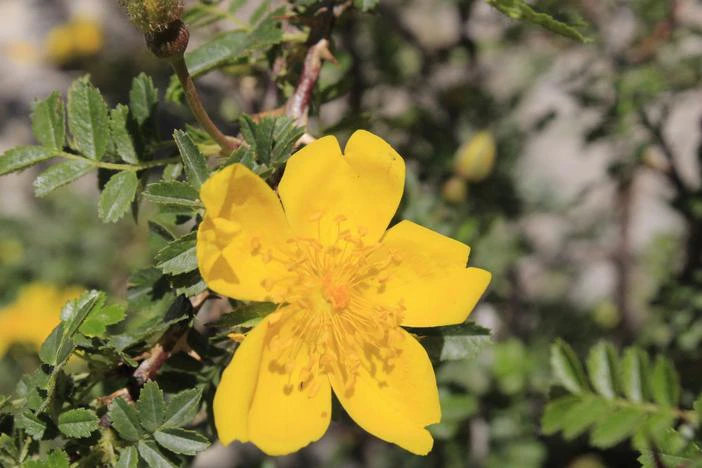Yellow Rose Of The Himalayas
(Rosa ecae)
Yellow Rose Of The Himalayas (Rosa ecae)
/
/

Humoyun Mehridinov
CC BY-SA 4.0
Image By:
Humoyun Mehridinov
Recorded By:
Copyright:
CC BY-SA 4.0
Copyright Notice:
Photo by: Humoyun Mehridinov | License Type: CC BY-SA 4.0 | License URL: https://creativecommons.org/licenses/by-sa/4.0 | Uploader: Humoyun Mehridinov | Publisher: Wikipedia Commons







Estimated Native Range
Climate Requirements for Fort Mill, South Carolina
| This Plant | Your Site | Plant Suitability for Your Location | ||
|---|---|---|---|---|
| • Precipitation | 7" - 59" | 47" | Aquatic | Aquatic |
| • High Temp. | 69°F - 105°F | 89°F | Your summer temperatures are normal for this plant. | Excellent |
| • Low Temp. | -9°F - 34°F | 30°F | Your winter temperatures are normal for this plant | Excellent |
This plant may not grow well at your location - your precipitation is too high.
Summary
Rosa ecae, commonly known as Yellow Rose of the Himalayas, is a deciduous subshrub native to rocky slopes and scrublands of the Western Himalayas and Central Asia. It typically grows to a height and width of 3-6 feet (0.9-1.8 meters), forming a rounded, bushy habit. The plant is characterized by its single, bright yellow flowers that bloom in spring and early summer, providing a striking display against the green foliage. The flowers are not particularly fragrant, which is atypical for roses. Rosa ecae is valued for its hardiness and drought tolerance once established, making it a suitable choice for rock gardens, mixed borders, and xeriscaping.
The Yellow Rose of the Himalayas thrives in full sun and requires medium amounts of water, preferring well-drained soils. It is relatively low-maintenance, but gardeners should be aware of common rose afflictions such as black spot and powdery mildew. Pruning is recommended to maintain shape and encourage blooming. This species is not known for aggressive roots or significant disease problems, making it a reliable choice for gardeners seeking a resilient flowering shrub.CC BY-SA 4.0
The Yellow Rose of the Himalayas thrives in full sun and requires medium amounts of water, preferring well-drained soils. It is relatively low-maintenance, but gardeners should be aware of common rose afflictions such as black spot and powdery mildew. Pruning is recommended to maintain shape and encourage blooming. This species is not known for aggressive roots or significant disease problems, making it a reliable choice for gardeners seeking a resilient flowering shrub.CC BY-SA 4.0
Plant Description
- Plant Type: Shrub
- Height: 3-6 feet
- Width: 3-6 feet
- Growth Rate: Moderate
- Flower Color: Yellow
- Flowering Season: Spring, Summer
- Leaf Retention: Deciduous
Growth Requirements
- Sun: Full Sun
- Water: Medium
- Drainage: Medium
Common Uses
Bee Garden, Bird Garden, Butterfly Garden, Fragrant, Hummingbird Garden, Showy Flowers
Natural Habitat
Rocky slopes and scrublands of the Western Himalayas and Central Asia
Other Names
Common Names: Smörblomsros
Scientific Names: Rosa ecae, Rosa xanthina var. ecae, Rosa mogoltavica, Rosa pedunculata
GBIF Accepted Name: Rosa ecae Aitch.